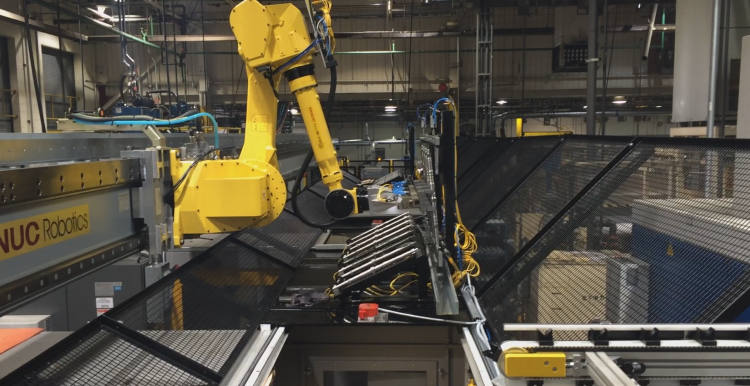
Case Study - Multi-Gundrill Loading Robot System
The Customer:
A large multinational auto-parts manufacturer needed to automate the production of transmission shafts. One of the key steps in the process is to drill a series of deep holes in the end of the shaft to deliver control hydraulics to the shifting mechanisms. This process required four gun-drill machines drilling four shafts simultaneously to keep up with procution.
Opus Automation has been a key player in this automation market and was brought in to look at the problem. We proposed an overhead rail-mounted robot capable of servicing all four machines, plus picking and placing the parts from/to buffered conveyors at "ground-level". Additional gauging requirements for dimensional checking of parts etc. had to be included.
The conveyors were also part of the scope and required the parts to be transferred around the corner to the next operation in the line.
A full control system for this system was designed to synchronize the production through all four machines.
Challenges:
- The robot must handle four shafts at a time since this was the design of the gun-drills.
- Once four parts are completed, they must drail for one whole machine cycle to recover as much of the cutting oil as possible. The oil is drained back into the machine, filtered and re-used.
- The handling required a buffer position at each machine to temporarily stock inbound shafts while the machine is being unloded to the drain station.
Solution:
- We analyzed the cell requirements and determined that one robot could keep all four machines lines running at the needed throughput.
- The machines operate asynchronously so the sequence varies. In effect the cell contyroller is a state machine, always watching for changes to determine the next action for the automation.
- Oil running out of the parts after machinig was a major problem to be solved. In the end a large drain trough was used under each drain station to collect the oil while allowing the robot to run at maximum speed.
Benefits:
- Increased productivity and throughput moving from a manual operation to the robotic operation.
- Eliminated repetitive strain problems due to solving the problem of reaching into the drills.
- Oil recovery saved significant environmental and safety issues.
- The overhead linear rail robot saved major floor space and allowed the plant to meet its cost targets.
Back
